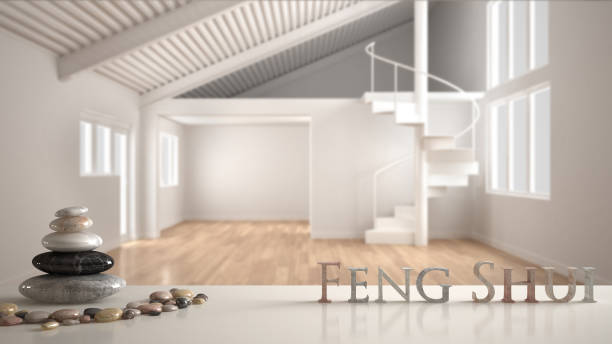Feng Shui Basics
Introduction to Feng Shui Principles: Understanding the Basics for Harmonious Living Spaces
Feng Shui, an ancient Chinese practice that dates back over 3,000 years, is centered on creating harmonious and balanced living spaces that promote positive energy and well-being. Rooted in the belief that the environment significantly impacts our health, prosperity, and happiness, Feng Shui emphasizes the careful arrangement of space, furniture, and decor to encourage the flow of good energy, or “Chi.”
Whether you’re looking to improve your home’s ambiance, attract success, or foster better relationships, Feng Shui principles can provide valuable insights into optimizing your living spaces. In this introduction to Feng Shui, we’ll explore the basic concepts that form the foundation of this timeless practice.
1. The Core Concept of Chi (Energy)
At the heart of Feng Shui is the concept of “Chi,” which represents the invisible life force or energy that flows through everything. According to Feng Shui principles, Chi must be able to flow smoothly through your living spaces to promote good health, fortune, and happiness. If Chi is blocked or stagnant, it can lead to negative consequences such as stress, financial difficulties, or relationship problems.
How to Apply It:
- Open Pathways: Arrange furniture and objects to allow free movement throughout the room, avoiding clutter and obstructions that can block Chi.
- Balance Yin and Yang: Feng Shui seeks to balance the opposing forces of Yin (calm and receptive energy) and Yang (active and dynamic energy) to create harmony.
2. The Five Elements: Fire, Earth, Metal, Water, and Wood
The Five Elements—Fire, Earth, Metal, Water, and Wood—are essential components of Feng Shui, each representing different aspects of life. Balancing these elements in your home ensures that energy flows harmoniously and supports your personal and professional goals.
The Elements and Their Meanings:
- Fire: Associated with passion, energy, and transformation. It is represented by red colors, candles, and triangular shapes.
- Earth: Symbolizes stability, nourishment, and grounding. Earth is represented by natural tones, square shapes, and materials like stone and clay.
- Metal: Associated with clarity, precision, and efficiency. Represented by white, metallic objects, and circular shapes.
- Water: Symbolizes abundance, flow, and emotional depth. It is represented by blue and black colors, wavy shapes, and water features like fountains or aquariums.
- Wood: Associated with growth, vitality, and creativity. Represented by green, plants, and rectangular shapes.
How to Apply It:
- Element Placement: Incorporate the elements into your decor by using color schemes, shapes, and materials that correspond to each element in appropriate areas of your home.
- Balance: Ensure no element dominates the space by adjusting the decor to maintain equilibrium. For instance, add plants (Wood) to soften a room dominated by Metal objects.
3. The Bagua Map: Mapping Energy Across Spaces
The Bagua map is a Feng Shui tool used to divide a space into nine zones, each corresponding to different aspects of life, such as wealth, love, career, and health. Applying the Bagua map helps you identify which areas of your home influence specific areas of your life, allowing you to make adjustments that enhance the flow of Chi.
How to Apply It:
- Align the Map: Overlay the Bagua map onto your home’s floor plan by aligning the entrance of your home with the “Career” sector of the map.
- Enhance Key Areas: Once you’ve identified key areas, such as wealth or relationships, enhance those spaces with appropriate elements. For example, placing a water feature in the wealth corner can help attract prosperity.
4. Furniture Arrangement for Energy Flow
Feng Shui places great importance on how furniture is arranged within a room. The layout of furniture can influence the flow of energy and the overall feeling of the space. Poorly arranged furniture can create blockages in Chi and lead to discomfort, while a well-arranged space can invite calm, creativity, and prosperity.
How to Apply It:
- Command Position: Position important furniture, such as the bed or desk, in a “commanding position,” meaning it should face the door but not be directly in line with it. This positioning allows you to feel in control and receptive to opportunities.
- Avoid Clutter: Clear unnecessary items and clutter, especially in areas such as hallways and entrances, to allow the free flow of energy throughout the home.
5. Enhancing Energy with Color
In Feng Shui, color is a powerful tool that influences the mood and energy of a space. Each color corresponds to one of the five elements, and using the right colors in the right areas can boost the positive energy in your home.
How to Apply It:
- Use Color Purposefully: Consider the energy you want to attract when selecting colors for your home. For example, red can energize a space, while blue encourages calm and relaxation.
- Balance Colors: Avoid overwhelming a room with too much of one color. Balance strong colors with neutral tones to create harmony.
6. Harmonizing Your Home for Health and Happiness
The goal of Feng Shui is to create a balanced environment that supports your overall well-being. By paying attention to the flow of Chi, balancing the five elements, and optimizing your home’s layout, you can design a living space that promotes harmony, health, and happiness.
Actionable Tips:
- Keep Entrances Clear: Make sure that your home’s entrance is well-lit and free from clutter to invite positive energy.
- Incorporate Nature: Add plants, water features, or natural materials to connect with nature and bring calming energy into your space.
- Prioritize Cleanliness: Clean and declutter your home regularly to maintain the flow of positive Chi and prevent stagnation.
Conclusion: The First Step Toward Harmonious Living
Feng Shui is more than just an interior design trend; it’s a way of creating a home that supports your well-being, success, and happiness. By understanding and applying the basics of Feng Shui, such as managing Chi, balancing the five elements, and using the Bagua map, you can transform your living spaces into areas of peace and positivity. Whether you’re new to Feng Shui or looking to refine your approach, these principles provide a strong foundation for creating harmonious and vibrant living environments.

